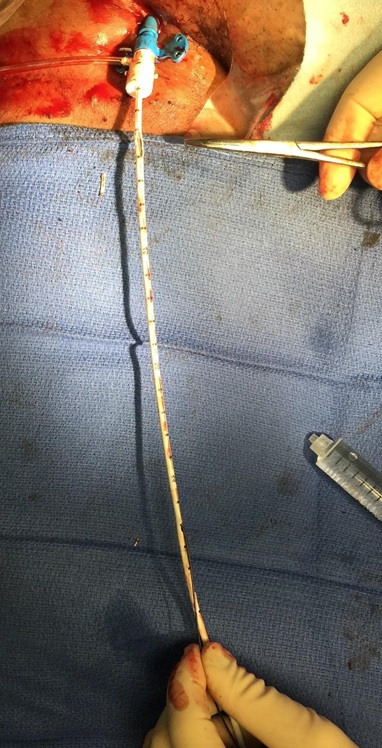A Novel Technique for Removal of ImpellaŽ Device While Maintaining Vascular Access
Christine L. Shokrzadeh, Kaled Diab, Zulfiqar F. Cheema, Michael B. Silva, Charlie C. Cheng.
UTMB, Galveston, TX, USA.
Objectives: The ImpellaŽ(Abiomed, Danvers, MA) is a temporary ventricular assist device for patients with severe CAD, left-sided heart failure, and cardiogenic shock. Traditionally, the ImpellaŽ devices are removed via surgical repair of the common femoral artery, or percutaneously with applied pressure at the access site to achieve hemostasis. However, hemostasis can be difficult to obtain with pressure due to large sheath size. Additionally, many patients are critically ill, precluding them from undergoing open femoral repair. We describe a novel endovascular approach to remove ImpellaŽ devices while maintaining vascular access, thus minimizing the need for open surgical repair. Methods: The ImpellaŽ catheter is pulled back until the pump motor is at tip of the sheath. Two small holes are made on the catheter. The distance between the two holes is at least the length of the sheath. An angled wire is inserted at the proximal hole and advanced until its tip is at the distal hole. Holding both the wire and the catheter, the pump motor is advanced to the aortic bifurcation. The wire is advanced to the descending thoracic aorta. Then, the wire, catheter, and sheath are pulled back until the pump motor and sheath are out of the patient. Using the Seldinger technique, the ImpellaŽ and sheath are exchanged for a suture mediated closure device.Results: This report illustrates three cases in which the patients underwent successful removal of the ImpellaŽ device while maintaining vascular access. Case 1 describes a patient who underwent ImpellaŽ insertion followed by inability to achieve groin hemostasis with manual pressure. Case 2 describes a patient with cardiogenic shock requiring full cardiopulmonary support with ImpellaŽ and ECMO. The patient was at high risk for hemorrhage and too unstable to transport to OR. Case 3 describes a patient with cardiogenic shock who underwent PCI and ImpellaŽ insertion. Subsequently, the patient developed a left ventricular thrombus. Conclusion: The technique described here for removal of the ImpellaŽ while maintaining vascular access for placement of a suture-mediated closure device is crucial to reduce the risk of major bleeding and the need for open surgical repair in critically ill patients. 
Back to 2018 ePosters




